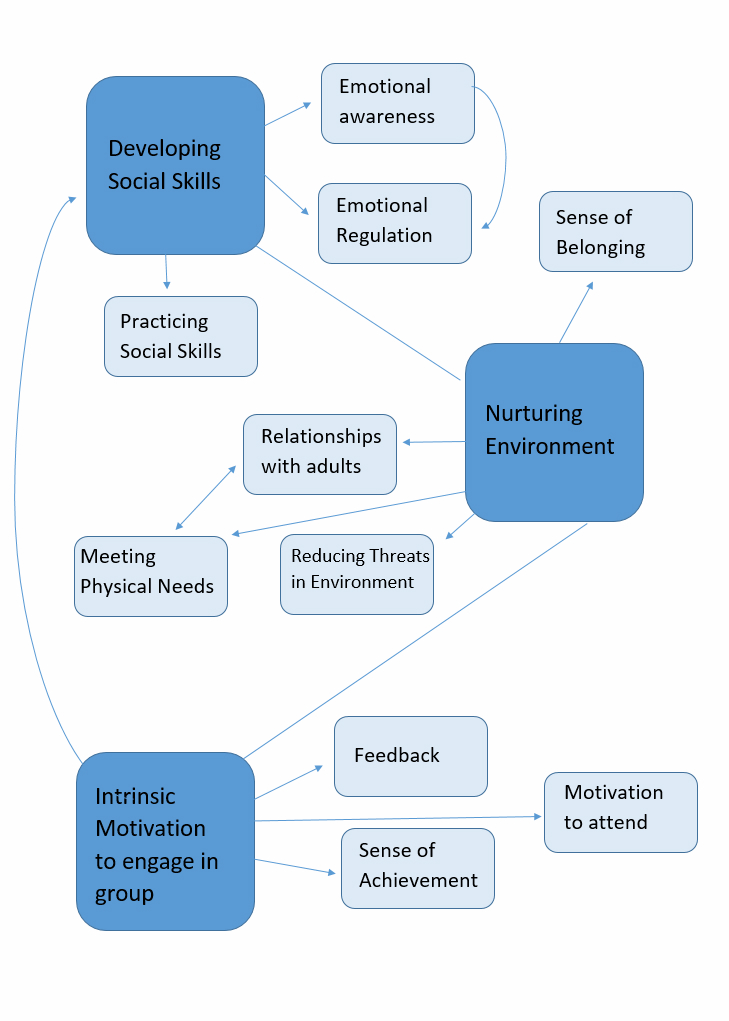Assignment type: Research Project (Small Scale Research Project, Year 1)
Authors: Chantelle Zilli, Rebecca Neudegg, Eleanor Hayes, Ed Sayer and Hanna Kovshoff
Submitted: Spring 2017
The objective of this study was to understand children’s experience of a therapeutic programme designed to build resilience in Children Looked After (CLA), aged 8 to 12 years old. Researchers show that compared to the general population, CLA are at risk of poor outcomes such as mental health difficulties (McAuley & Davis, 2009), low academic achievement (O’Sullivan & Westerman, 2007) and youth offending behaviour (Jonson-Reid & Barth, 2000). This may be due to adverse experiences both pre-care and within the care system which are associated with poor social, emotional and educational development in CLA (Sempik, Ward, & Darker, 2008; Ward, 2009). It is therefore important to develop interventions which remediate these risks.
Building resilience is one approach to supporting the needs of CLA. ‘Resilience’ is the capacity to “bounce back” from adverse experiences; importantly, it is not a trait but a skill that can be developed through environmental factors such as peer, school and neighbourhood support (Dent & Cameron, 2003). Building resilience is therefore not only a strengths based approach but acknowledges the role of adults in the environment in supporting CLA. There appears to be, however, little research on the use of resilience based interventions in the CLA population with many focussing on academic achievement and attendance (Liabo, Gray, & Mulcahy, 2013) or support for children in foster care (Leve et al., 2012). The authors chose to focus on children’s experience of intervention as research shows their perspectives can differ from adults’ (Holland, 2009) and that CLA want to be involved in shaping these interventions (Munro, 2001; Golding, Dent, Nissim, & Stott, 2006).
Method
Semi-structured interviews were conducted with participants who attended a minimum of eight therapeutic sessions. Seven of the eight group attendees took part (4 girls, 3 boys; mean age 10 years, 5 months). The questions were shaped using feedback from a focus group of previous attendees. The interview took place in a quiet room with the educational psychologist facilitating the programme nearby. Regular breaks were given and each interview lasted 20 – 30 minutes. The interviews were recorded on a secure encrypted electronic device and later transcribed verbatim. The researchers followed Braun and Clarke’s six step to thematic analysis (Braun & Clarke, 2006) to extract latent themes from the data and these were analysed within a social constructionist framework.
Results and discussion
After thematic analysis was completed, three main themes and ten sub-themes were evident to the researchers (summarised in the diagram below).
- All participants shared views about awareness of their own and others’ emotions and how they had developed, or demonstrated social skills in the intervention.
- Positive relationships with staff and other CLA as well as activities that met children’s physical needs (such as snack time, exercise and sensory activities) appeared to create an environment that is nurturing and welcoming. However, the physical environment, such as pillars in the building where the intervention took place may have negatively impacted feelings of safety.
- An overarching pattern across the data set was the positive evaluations of the intervention and specific activities within it.
This research could aid understanding of processes that promote resilience in primary aged CLA. This therapeutic programme, for example, appears to have promoted social skills, caring relationships and active participation which are all considered protective factors that promote resilience (Brooks, 2006). Furthermore, the findings suggest that learning was embedded in activities and interactions. Thus, environmental factors may have facilitated the development of CLA social skills. This may correspond to a protective-protective model of resilience whereby benefits of one factor is perpetuated by another (Brook, Whiteman, Gordon & Cohen, 1986).
References
Brook, J. S., Whiteman, M., Gordon, A. S., & Cohen, P. (1986). Dynamics of childhood and adolescent personality traits and adolescent drug use. Developmental Psychology, 22(3), 403.
Brooks, J.E. (2006). Strengthening resilience in children and youths: Maximising opportunities through the schools. Children and Schools, 28(2), 69–76.
Braun, V., & Clarke, V. (2006). Using thematic analysis in psychology. Qualitative Research in Psychology, 3, 77–101. http://doi.org/10.1017/CBO9781107415324.004
Dent, R. J., & Cameron, R. J. S. (2003). Developing Resilience in Children Who are in Public Care: The educational psychology perspective. Educational Psychology in Practice, 19(1), 3–19. http://doi.org/10.1080/0266736032000061170
Holland, S. (2009). Listening to children in care: A review of methodological and theoretical approaches to understanding looked after children’s perspectives. Children and Society, 23(3), 226–235. http://doi.org/10.1111/j.1099-0860.2008.00213.x
Jonson-Reid, M., & Barth, R. P. (2000). From placement to prison: The path to adolescent incarceration from child welfare supervised foster or group care. Children and Youth Services Review, 22(7), 493–516. http://doi.org/10.1016/S0190-7409(00)00100-6
Leve, L. D., Harold, G. T., Chamberlain, P., Landsverk, J. A., Fisher, P. A., & Vostanis, P. (2012). Practitioner review: Children in foster care–vulnerabilities and evidence-based interventions that promote reslience processes. Journal of Child Psychology and Psychiatry, 53(12), 1197–1211. http://doi.org/10.1111/j.1469-7610.2012.02594.x.Practitioner
Liabo, K., Gray, K., & Mulcahy, D. (2013). A systematic review of interventions to support looked-after children in school. Child and Family Social Work, 18(3), 341–353. http://doi.org/10.1111/j.1365-2206.2012.00850.x
McAuley, C., & Davis, T. (2009). Emotional well-being and mental health of looked after children in England. Child and Family Social Work, 14(2), 147–155. http://doi.org/10.1111/j.1365-2206.2009.00619.x
O’Sullivan, a., & Westerman, R. (2007). Closing the Gap: Investigating the Barriers to Educational Achievement for Looked after Children. Adoption & Fostering, 31(1), 13–20. http://doi.org/10.1177/030857590703100104
Sempik, J., Ward, H., & Darker, I. (2008). Emotional and Behavioural Difficulties of Children and Young People at Entry into Care. Clinical Child Psychology and Psychiatry, 13(2), 221–233. http://doi.org/10.1177/1359104507088344
Ward, H. (2009). Patterns of instability: Moves within the care system, their reasons, contexts and consequences. Children and Youth Services Review, 31(10), 1113–1118. http://doi.org/10.1016/j.childyouth.2009.07.009

